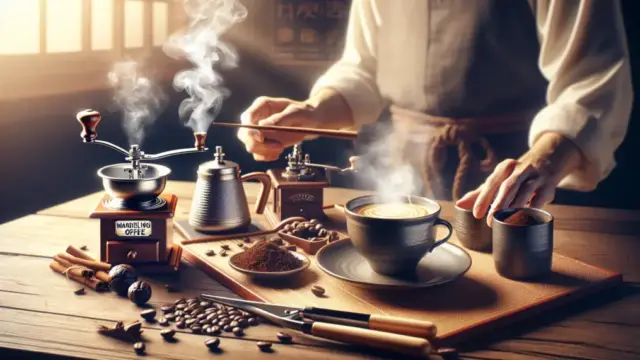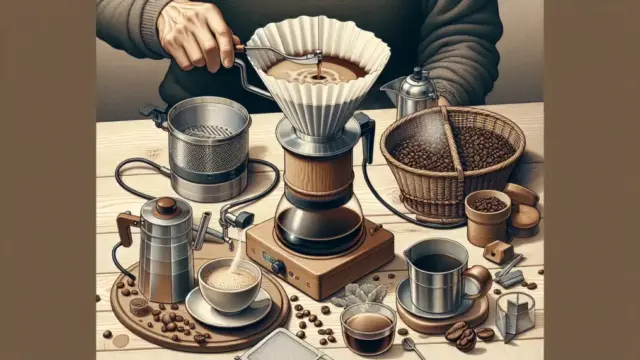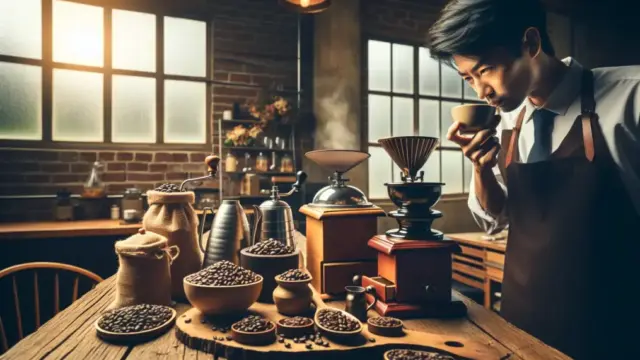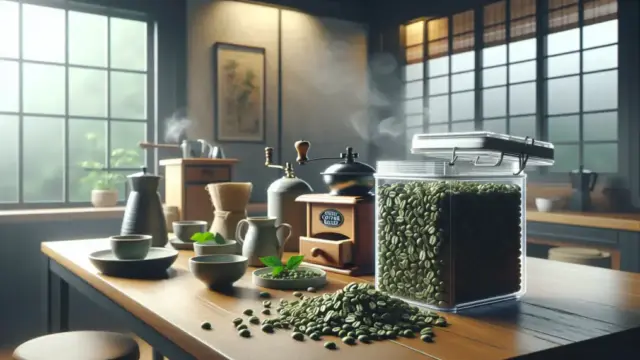To truly enjoy coffee, it’s crucial to maintain its rich flavor. Knowing the right storage methods can make your daily cup feel even more special. Interestingly, the way coffee is stored is influenced by various cultures around the world, each adding their unique twist to the process. In this article, we’ll explore essential tips for keeping your coffee tasting great, along with a look at cultural perspectives on coffee preservation.
We’ll also share some easy storage techniques that you can implement at home, enhancing your coffee experience. So, let’s dive into the world of coffee storage together!
- Essential knowledge for preserving coffee’s flavor
- An overview of storage methods rooted in different cultures
- Simple home storage techniques
The Basics of Preserving Coffee Flavor
To truly enjoy the flavor of coffee, maintaining its freshness is essential. Using fresh coffee beans enhances the aroma and taste, making your daily coffee ritual even more delightful. However, coffee beans are prone to oxidation over time, which can diminish their flavor. Therefore, knowing the right storage methods is crucial.
In this section, we will explore the importance of freshness and how to manage temperature and humidity when storing coffee. By understanding these factors, you can prolong the enjoyment of your coffee’s rich flavors.
The Importance of Freshness
Fresh coffee beans are brimming with rich aromas and flavors, significantly enhancing your drinking experience. After roasting, the beans begin to oxidize over time, leading to a decline in flavor quality. For this reason, enjoying coffee as fresh as possible is vital. Generally, beans are considered to be at their peak taste within one to two weeks after roasting.
To maintain freshness, it’s essential to check the roast date when purchasing and to consume the beans as soon as possible. Additionally, dividing your coffee into smaller portions for storage can be an effective way to keep it fresh.
- Fresh coffee beans offer rich aromas and flavors
- The best taste is within one to two weeks after roasting
- Checking the roast date at purchase is crucial
Proper Temperature and Humidity Management
When storing coffee, temperature and humidity are also important factors. The ideal temperature for storage is room temperature, with humidity around 50%. Storing coffee in high temperatures or humid environments can lead to quicker deterioration. Moreover, excessive moisture can foster mold and spoilage.
A cool, dark place is the best option for storage. It’s advisable to avoid the refrigerator, as fluctuating temperatures can negatively affect the beans. Using an airtight container for storage helps preserve flavor. By carefully managing temperature and humidity, you can significantly extend the life of your coffee’s flavor.
- Ideal storage temperature is room temperature, with humidity around 50%
- High temperatures and humidity can lead to deterioration
- It’s important to store in a cool, dark place in an airtight container
Learning from Culture: How to Store Coffee
Coffee is a beloved beverage enjoyed worldwide, and its storage methods vary greatly by country and region. Each culture’s approach to preserving coffee is filled with unique insights and innovations. In this article, we’ll explore different coffee storage techniques from around the globe, uncovering tips that you can easily incorporate into your daily coffee routine.
Understanding the storage methods rooted in cultural backgrounds can deepen your appreciation for coffee’s flavors. By learning about the distinctive practices of various countries, you can enhance your own coffee experience.
Storage Methods Around the World
Coffee storage practices differ from one country to another. For instance, in Italy, coffee beans are stored in airtight containers kept in a cool, dark place. This method helps maintain the beans’ aromatic qualities for a longer time. On the other hand, in Ethiopia, it’s common to store coffee beans in traditional bamboo tubes, which effectively protect the beans from moisture and pests.
Additionally, in Brazil, coffee beans are often kept in bags at room temperature. The best storage method can vary based on the type of bean and its roast level, making it essential to understand the cultural context behind these practices.
- In Italy, store in airtight containers in a cool, dark place
- In Ethiopia, bamboo tubes protect against moisture and pests
- In Brazil, room temperature storage in bags is typical
Cultural Context of Storage
The way coffee is stored is heavily influenced by a country’s climate, traditions, and lifestyle. For example, in humid regions, special care is needed to prevent coffee beans from deteriorating. The bamboo storage method used in Ethiopia is a distinctive feature that makes use of natural materials.
Furthermore, coffee consumption habits also impact storage techniques. In countries where coffee is enjoyed daily, storage methods tend to be straightforward and practical. Conversely, in cultures where high-quality coffee is reserved for special occasions, more effort is typically put into its preservation. By understanding the cultural background behind these practices, you can gain a fresh perspective on coffee storage.
If you’re interested in learning more about coffee storage methods, check out this article on “How to Store Green Coffee Beans for Freshness”. It provides detailed insights on the ideal storage environment and container selection for green beans, equipping you with the knowledge to enjoy fresh coffee. Discover how to enhance your coffee’s flavor through effective storage techniques and enrich your daily coffee life.
- Storage methods are influenced by climate and tradition
- Ethiopia’s use of bamboo showcases natural material utilization
- Differences in storage reflect consumption habits
Coffee Storage Techniques You Can Use at Home
To enjoy coffee at its freshest, it’s essential to know the right storage techniques you can easily implement at home. By following simple methods, you can prolong the flavor of the coffee you drink daily. In this section, we’ll explore how the choice of storage containers and coffee beans can significantly impact the taste.
By keeping these points in mind, you’ll be able to enhance your daily coffee experience. Let’s dive into the coffee storage techniques that can elevate your coffee life!
Choosing the Right Storage Container
When it comes to storing coffee, the choice of container is crucial. An ideal storage container is airtight and protects against light. This helps prevent the beans from oxidizing, preserving their aroma and flavor. Glass or ceramic containers are highly recommended, while plastic ones should generally be avoided.
The size of the container is also an important consideration. By storing only what you need in smaller portions, you can maintain freshness. Since coffee beans deteriorate when exposed to air, a compact container that allows you to take out just the amount you need is perfect.
- An airtight, light-blocking container is ideal
- Glass or ceramic is recommended
- Store in smaller portions to keep it fresh
Choosing Beans and Their Impact
Not only is how you store coffee important, but the selection of beans also plays a significant role. Choosing fresh beans can drastically alter the flavor after storage. Selecting beans with a clearly marked roast date is the first step to enjoying high-quality coffee. Generally, beans that are roasted within one to two weeks are considered the most flavorful.
Additionally, different types of beans may require different storage methods. For example, beans with fruity notes tend to lose their flavor quickly if not stored properly. In contrast, nutty-flavored beans are relatively easier to store. Understanding the characteristics of the beans can help you enjoy better coffee.
- Selecting fresh beans impacts quality
- Beans with a marked roast date are ideal
- Storage methods may vary depending on bean type
Tips for Keeping Your Coffee Fresh
If you want your coffee to last longer, there are several important factors to consider. Light and air are two major culprits that can compromise the flavor of your coffee. By learning how to protect your coffee from these elements, you can maintain the quality of your stored beans. Additionally, it’s worth thinking about freezing your coffee. In this section, we’ll explore some practical tips for keeping your coffee fresh.
By understanding the characteristics of coffee and making some adjustments during storage, you can enjoy a tastier brew. Now, let’s dive into the specific precautions you should take.
Protecting Coffee from Light and Air
Coffee beans are extremely sensitive to light and air. When exposed to direct sunlight, the beans can oxidize quickly, resulting in a loss of flavor. Therefore, it’s crucial to choose storage containers that block light. It’s best to avoid clear glass containers and instead opt for darker, opaque ones.
Minimizing the time your coffee is exposed to air is also essential. When you’re ready to brew, only take out the amount you need and make sure to seal the remaining beans tightly. By taking these steps to shield your coffee from light and air, you can preserve its quality.
- Choose containers that block light
- Avoid transparent containers
- Minimize exposure to air
Is Freezing Coffee a Good Idea?
Freezing can be an effective way to extend the shelf life of coffee beans, but it requires some caution. While freezing may prevent oxidation and help preserve flavor, repeatedly freezing and thawing the beans can degrade their quality. For best results, when freezing, it’s important to portion out the coffee you’ll use and store it separately.
Moreover, after removing coffee from the freezer, it’s advisable to let it return to room temperature before brewing. This will help maximize the flavors of the beans. By using freezing wisely, you can enjoy delicious coffee for an extended period.
If you’re interested in how to store coffee effectively, check out this article on “Room Temperature Coffee Bean Storage! Secrets to Preserving Flavor”. It provides detailed insights on how to keep your coffee beans fresh at room temperature and specific tips for maintaining their flavor. This knowledge will enhance your coffee enjoyment.
- Freezing is effective for preventing oxidation, but be cautious
- Portion out coffee before freezing
- Let it return to room temperature before brewing
Conclusion
Reflecting on what we’ve learned about coffee storage, it’s clear how crucial it is to maintain freshness. By choosing the right storage containers and protecting your coffee from light and air, you can significantly prolong its flavor. Additionally, understanding the cultural backgrounds of different countries can inspire you with new ideas for coffee preservation methods. Let’s put some handy storage techniques into practice at home to enhance our daily coffee rituals.
Moreover, by deepening your understanding of freezing methods, you can enjoy your coffee for a longer period. Keeping these points in mind will surely enrich your coffee experience.
- The right storage container is key to keeping coffee fresh
- It’s important to protect your beans from light and air
- Freezing works best when coffee is divided into smaller portions
We encourage you to try out your own coffee storage methods! And feel free to share your coffee experiences and preservation techniques in the comments below.































































Comment